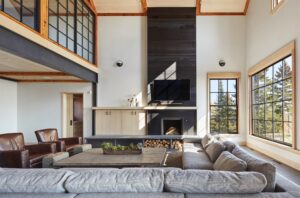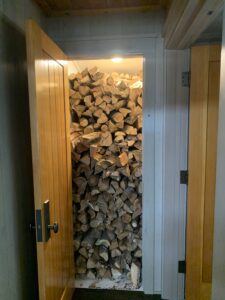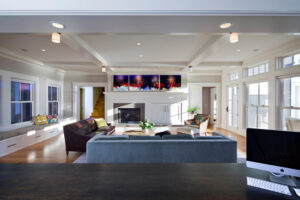Grab a cozy blanket, a cheeseboard, and a hot cup of tea and settle in for expert tips on how to choose the perfect fireplace for your home or cabin with Mark Tambornino, Managing Principal at the Minneapolis architecture firm Albertsson & Hansen Architecture.
The fireplace is perhaps one of the most alluring elements of a home. Emanating comfort, a fireplace has the capacity to call every soul in the house from their solitary positions in their individual rooms to one communal ground of warm connection.
This gathering symbol, whether it unites grandparents and grandchildren, life-long friends, lovers, or simply a homeowner with an enrapturing novel, provides a much-needed respite from the alienation of modern life. Everyone could benefit from an hour or two or three by the flames.
But, before a homeowner can reap the benefits of a personalized fireplace, there are a number of factors to consider, such as:
Will a gas-powered or wood-burning fireplace better align with your lifestyle?
Will you have a television on the same wall?
Will the fireplace act as the focal point of the room or merely an accessory?
“It always surprises me how different every single project is, just based on the circumstances of the families and the places that they live,” said Mark Tambornino, Managing Principal at Albertsson & Hansen Architecture, a Minneapolis-based architecture firm committed to designing timeless residential architecture and interior design.
“At the very beginning of the process we have a conversation where we try to nail down the feeling that you want to achieve with your fireplace. From there, we parse through how we can achieve that for the homeowner.”
Skilled in setting homeowners on the right track, Tambornino offers expert insights on when, why, and how to build the perfect fireplace for your home.
Step One: Gas or Wood?
This step is perhaps the most practical, but that does not mean that it should lack inspiration. Tambornino notes that meaning is often derived from functionality, not separate from it.
Here is what you should consider when deciding which type of fireplace is the best for your lifestyle:
Wood-burning – Arguably the most traditional style of fireplace, this kind of fireplace is excellent for homeowners who relish the sensory experience of burning wood. If the thought of scooping the rough logs in your arms, smelling the fresh cedar, and enjoying the warm glow of a physical flame is what attracts you to a fireplace, a wood-burning fireplace is right for you.

Photo: A wood-burning fireplace sits among plush, inviting furniture and is illuminated by the outdoor sunshine at a cabin in Tofte, Minnesota, near the shores of Lake Superior.

Photo: One lake homeowner was so enamored with the connection to nature they gained from a wood-burning fireplace that they dedicated a full closet in their home just to store wood. Firewood can be loaded from the outside and accessed from the inside, literally bringing the outside…in.
Gas burning – Able to be controlled with the flip of a switch, a gas-burning fireplace is best for the homeowner who prefers a more ‘hands-off’ approach to comfort. While gas fireplaces tend to appear more modern than traditional fireplaces, there is also the option to install a log set that mimics a wood-burning system with less hassle. It all depends on your vision for how you want to live your life in your home. Local building codes may play a factor, too.

Photo: This gas-burning fireplace is sleek and hands-off, allowing homeowners the option to enjoy comfort at the end of a long day with nothing more than a flip of a switch.
Step Two: Aesthetics and Materials
As with any step in crafting your ideal fireplace, this one will heavily depend on the story you would like your home to tell. Would you like the material to ebb and change over time? Are you looking to mimic the shapes and colors of the geographic region in your fireplace design? What heirlooms, if any, are you hoping to display around the fireplace? Will it be an open, sleek space or adorned with tchotchkes and hanging stockings?
Tambornino notes that he has recently been enamored with steel as a frame for a fireplace, because of its clean, yet ever-evolving nature. As the fireplace is ritually illuminated and extinguished and the elements interact over time, a portrait of sorts begins to take form on the steel’s surface, fossilizing the lived experience of the family in striking inkblots just as smile lines reflect a happy life on well-lived cheeks.
“Fire is a natural phenomenon and providing a context that amplifies that and tells the story of it is really important. It is always nice to use materials that have a natural quality about them that might change over time and move like the flames of a fire,” said Tambornino.
This is only one of many ways to instill your story into your fireplace. Tambornino reflects on a recent project where a homeowner approached him with a huge hickory log, thrilled at the idea of showcasing it somewhere in their house. After inquiring about the log, the homeowner told Tambornino that it is actually from a hickory tree that he had cut down with his brother. He wanted the memory immortalized in the house forever.


Before and after: A hickory log, a memento from the homeowner’s childhood is embedded above a steel-cased fireplace in King’s Point.
“When you get to tell a story like that, a project becomes so much fun,” said Tambornino. “At the time that we did their project, they were starting to have grandchildren, so a large part of it was wanting to share that story with them. Now, it’s something that his family gets to look at every single day, and he can tell that story 1,000 times with new guests and people who come over to visit.”
Step Three: Composition
So, now you’ve got your design down, but where does your fireplace sit in relation to the rest of the room, or even your home?
“It all starts with asking yourself: where do you want your center of attention to be?” said Tambornino. “Do you want the fireplace to be in your lake view or off to the side? More often than not, we’ll put it off to the side so that you can get an uninterrupted view of the outside. In that case, we take into account all of those other elements of the fire – how it radiates heat, the smell, and the sound. There are many compositional elements to consider.”
Furthermore, consider: what room do you want your fireplace(s) in? While the living room is the standard choice, homeowners can feasibly enjoy fireplaces in their bedrooms, offices, screened-in porches, or even in a bathroom. Don’t be afraid to get creative with it.
“Again, it is all part of that conversation of what kind of experience do you want to have with the fire?” said Tambornino. “There are a lot of preconceptions of where the fire should be, but I could see a fireplace in an office, a kitchen, a bedroom, or even a bathroom. I’ve done a wood stove in a bathroom, but a fire in a bathroom I think would be very fun. I just haven’t had a chance yet!”
Radiate Warmth Throughout Your Home
All of this goes to show that the intention behind a fireplace matters. After all, it is so much more than meets the eye. It is about how you experience your home, move through your life, and bond with others in your home. If you’re ready to get started, fill out Albertsson & Hansen Architecture’s online form to start actualizing your dream way of living.
Albertsson & Hansen Architecture: Thoughtful Design. Delightful Living.
Seeking more inspiration? To explore more beautiful projects, visit Our Portfolio.
To read more stories similar to this one, visit the blog on www.aharchitecture.com.

